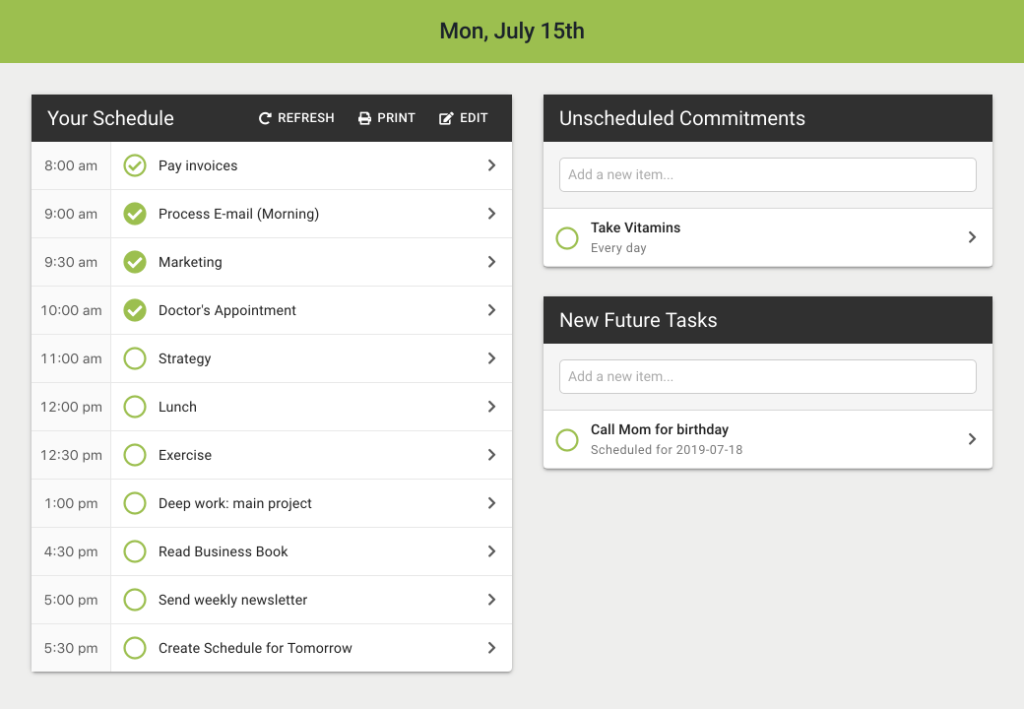One of the biggest challenges with effectively managing your time are those times when your time belongs to others—when you are not in control of when you get to do a task or activity.
Perhaps the biggest challenge comes from appointments which split your day into 2, 3, 4 or more pieces, making it difficult or impossible to have a solid block of time within which you can gain focus and flow.
The problem worsens when the energy of those appointments doesn’t fit into the rest of your day. You’re in a creative mood and producing new ideas and work, then suddenly an appointment brings you back in analysis mode and you lose your flow.
What strategies can you use to improve these days?
Read on for 4 tips you can use to plan and execute your days better.
1. Minimize Fragmentation
Simply reduce the amount of fragmentation your days have. Easier said than done!
Reducing fragmentation often involves trade-offs. More fragmentation on one day may provide less fragmentation on another.
Consider exploring these strategies:
- Schedule Fewer Appointments
Fewer appointments = less fragmentation. Take the time to scrutinize the appointments on your calendar and determine how important they truly are. Cancel lower priority appointments whenever possible. Mark non-critical appointments as optional, so you remember to re-evaluate them as they get closer. - Only Schedule 2 Weeks Out
Avoid scheduling (most) appointments too far in advance. It’s a trap for the planning fallacy, where we think we’ll have more time for the appointment in the future—you won’t. Unless you know you’ll have a huge reduction in commitments, if you wouldn’t schedule an appointment in the next two weeks, don’t schedule it further out. The exceptions here are recurring appointments and appointments that require advanced scheduling like doctor appointments. - Concentrate Your Appointments
Try to schedule all of your appointments on one or two days of the week and keep the rest of the week appointment-free. This creates one or two days a week with extreme fragmentation but with the advantage that the remaining days have no fragmentation. This is a good strategy if you have control of all of your appointments, since it gives you a few solid days where you can schedule deep work. - Distributing Appointments
When concentrating your appointments is not possible, consider distributing your appointments throughout the week. While this creates more days that are fragmented, the fragments are larger, which allow you to be more productive within them. This works best when you have 5 or fewer appointments a week, and when you can adjust the schedule of some of your appointments, but not all of them. - Schedule Appointments Early or Late
When you have the option to choose an appointment time, schedule appointments at either the beginning or end of your day. This allows you to have a large block of time in the middle of your day to get productive work done. Make this a rule that you can communicate to others, e.g.. “I prefer early morning appointments”. This avoids the need to strategically think about each appointment when it is being made, and gives you a way to easily ask others for appointments that match your needs.
Which strategy works for you will depend on how much control you have over setting your appointments and how much flexible time you require in your day to be most productive.
2. Chain Your Fragments Together
Once your day is fragmented, how do you make the most of those fragments?
One strategy is “time block chaining” where you connect one fragment to the next fragment to build momentum over multiple time blocks or fragments.
To do this, use a time block blueprint that looks like this:
- Restore State: 5 min
Review the notes from your last fragment to get the context of what you are working on back in your head. If you saved the state of your workspace, restore that state so you can resume quickly. - Do Work: remaining time
Do the actual work that you need to do in this fragment. Remember to leave time at the end, however, to save your state. - Save State: 5 min
Write down everything that is in your head. Jot down the next couple steps you need to take when you resume, so you have a place to start. If you can, save the state of your workspace (e.g., I use Workona to save my browser state and several of my desktop apps automatically save their state).
When you first try this strategy, you may find yourself lost during the next fragment. But as you practice and learn what notes you need to take to quickly resume, you’ll find yourself able to chain multiple smaller fragments together and work almost as productively as if they were a single larger fragment.
Of course, this only works if your fragments are at least some minimum duration. Chaining together eight 15-minute fragments isn’t going to be the same as doing two 60-minute fragments or a single 2-hour time block.
3. Use Fragments Wisely
When your fragments are too short to chain together, use them to remove distractions or obstacles so that later longer fragments can be more productive.
Try these strategies:
- Clear the Plate
Use space between appointments and other fixed blocks of time to do administrative stuff and remove stuff off your Eliminate Drag List. Take this time to do necessary grunt work or work that helps you stay more focused later. - Prime the Pump
Use these fragments to warm up, so you can use that momentum later in the day. Need to write later in the day? Review your research or your latest draft during a small fragment to get your subconscious thinking about it. Have work that requires prep to get started? Do that prep during an earlier fragment so you can jump in and get started once you have a longer time block. - Relax and Renew
Take the time to relax and renew your energy. This can either be short-term focused—where you take a pause to gain energy later that day—or long-term focused such as doing a short exercise session to maintain your fitness for the future.
The important thing is to be deliberate with how you use these fragments instead of mindlessly scrolling through social media or considering them simply wasted time.
4. Align Energy to Fragments
When possible, ensure your energy before and after any appointments aligns with the appointment itself. If you have multiple appointments in a single day, consider the energy they require of you and use one of these strategies:
- Batch Similar Appointments
Schedule appointments that require the same type of thought and energy together. For instance, schedule all of your administrative appointments on one day, all of your errands on another, all of your strategy meetings on another. The idea here is to get into a thinking mode and stay there to build momentum. - Harmonize Different Appointments
Schedule appointments that require different types of thought and energy together. For instance, schedule a strategy session, followed by a doctor’s appointment, followed by an employee meeting. The idea here is to give yourself time to recover one type of energy while you use another. - Use Appointments as Energy Shifts
Schedule appointments to specifically shift your energy at times in your day. For instance, as a night owl, I start my day slowly. But sometimes I’ll schedule an early morning appointment to shift myself into a work mode earlier, so I can finish early that day. Likewise, an early bird might schedule a late afternoon appointment to help them end work early.
Which of these you use will depend on your personal preferences. Experiment with different strategies to see what works best for you.
Conclusion
Fragmented days can be a productivity killer if you let them be. However, you have more control than you think. Take steps to avoid fragmentation when possible by scheduling only 2 weeks out, using rules for when you schedule appointments and saying no more.
When fragmentation occurs, chain your fragments together to maintain momentum, or use those fragments wisely when this is not possible.
Finally, remember that it’s not just about how fragmented your day is, but what you are doing within those fragments. Take the time to learn how to optimize your energy by either batching similar appointments or harmonizing different appointments. And use those early morning or late afternoon appointments to shift your energy strategically.








